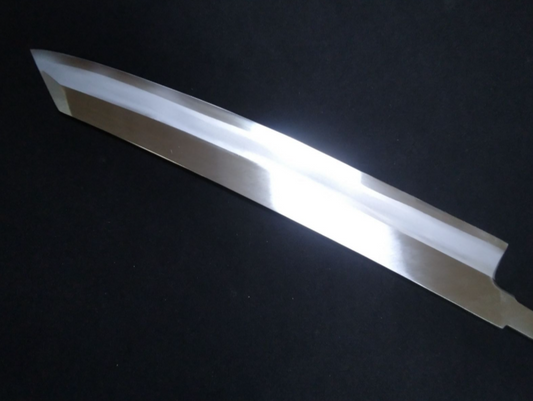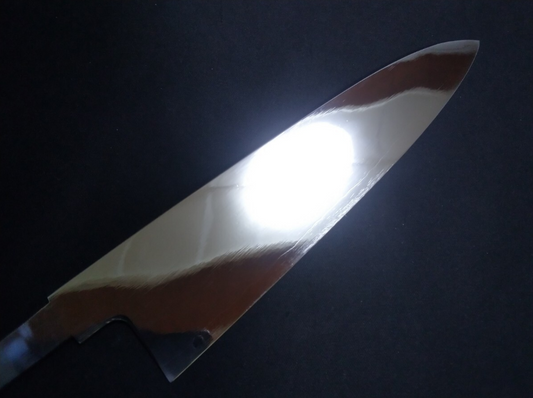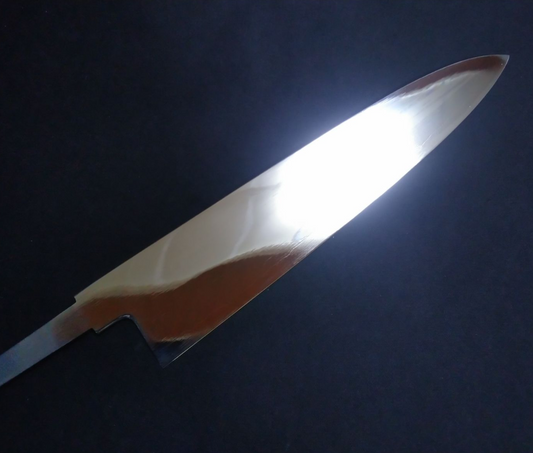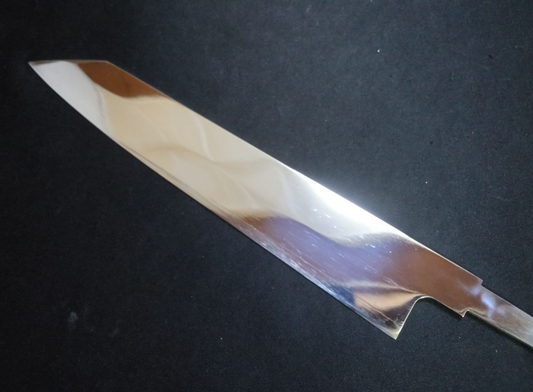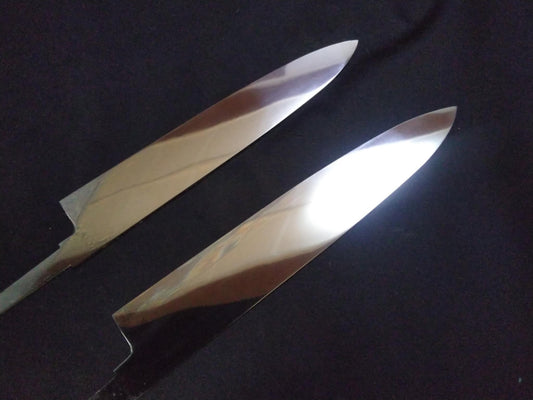
Gyuto
-
The Japanese Evolution of the Chef’s Knife
Western versatility, Japanese precision.
The Gyuto moves with you — slicing meat, fish, and vegetables with effortless grace.
It’s not just a knife. It’s a partner in your craft. -
Gyuto Collection
-

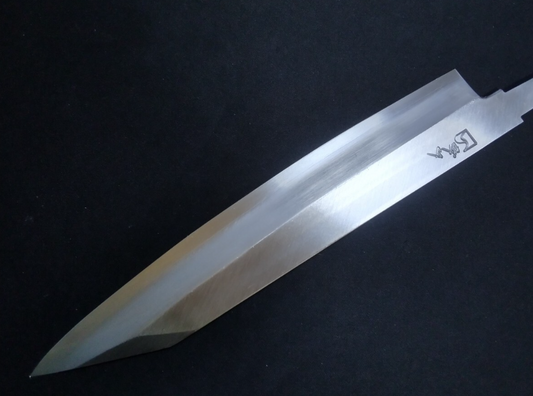 Sold out
Sold outGinsan Gyuto 240mm -Kido Finishing
Regular price $410.00 CADRegular priceUnit price / per$0.00 CADSale price $410.00 CADSold out -
Blue Steel #2 Gyuto 270mm-Kido Finishing
Regular price $420.00 CADRegular priceUnit price / per$0.00 CADSale price $420.00 CADSold out -
Ginsan Gyuto 210mm -Mirror Polished(both sides)
Regular price $430.00 CADRegular priceUnit price / per$0.00 CADSale price $430.00 CAD -
Ginsan Gyuto (Kiritsuke) 240mm -Kido Finishing
Regular price $460.00 CADRegular priceUnit price / per$0.00 CADSale price $460.00 CADSold out -
Ginsan Gyuto 240mm -Mirror Polished(both sides)
Regular price $490.00 CADRegular priceUnit price / per$0.00 CADSale price $490.00 CAD -
Ginsan Gyuto (Kiritsuke) 240mm -Polished(both sides)
Regular price $510.00 CADRegular priceUnit price / per$0.00 CADSale price $510.00 CAD -
Super Steel (Honyaki) Gyuto 210mm-Mirror Polished(both sides)
Regular price $570.00 CADRegular priceUnit price / per$0.00 CADSale price $570.00 CADSold out -
Super Steel (Honyaki) Japanese-style Gyuto 240mm-Mirror Polished(both sides)
Regular price $570.00 CADRegular priceUnit price / per$0.00 CADSale price $570.00 CAD -

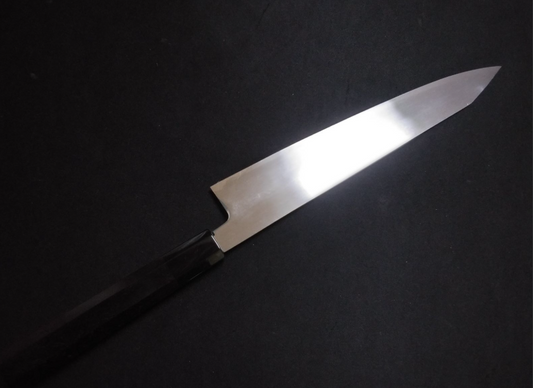 Sold out
Sold outZDP189 Gyuto (Kiritsuke) 240mm
Regular price $570.00 CADRegular priceUnit price / per$0.00 CADSale price $570.00 CADSold out -
Blue Steel #1 Damascus Gyuto 210mm- Mirror Polished Blur Finish
Regular price $584.00 CADRegular priceUnit price / per -
Super Steel (Honyaki) Gyuto 240mm-Mirror Polished(both sides)
Regular price $590.00 CADRegular priceUnit price / per$0.00 CADSale price $590.00 CADSold out -
Ginsan Gyuto 270mm -Mirror Polished(both sides)
Regular price $590.00 CADRegular priceUnit price / per$0.00 CADSale price $590.00 CAD -
ZDP189 Gyuto (Kiritsuke) 270mm
Regular price $610.00 CADRegular priceUnit price / per$0.00 CADSale price $610.00 CAD -
Blue Steel #1 Damascus Gyuto 240mm- Mirror Polished Blur Finish
Regular price From $631.00 CADRegular priceUnit price / per -
ZDP189 Gyuto 240mm-Mirror Polished(both sides)
Regular price $710.00 CADRegular priceUnit price / per$0.00 CADSale price $710.00 CAD -
ZDP189 Gyuto (Kiritsuke) 270mm -Mirror Polished(both sides)
Regular price $750.00 CADRegular priceUnit price / per$0.00 CADSale price $750.00 CAD
KIREAJI's Three Promises to You
-

1. Forged in the Legacy of Sakai
From Sakai City—Japan’s renowned birthplace of professional kitchen knives—each blade is crafted by master artisans with over six centuries of tradition. Perfectly balanced, enduringly sharp, and exquisitely finished, every cut carries the soul of true craftsmanship.
-

2. Thoughtful Care for Everyday Use
Every knife includes a hand-fitted magnolia saya for safe storage. Upon request, we offer a complimentary Honbazuke final hand sharpening—giving you a precise, ready-to-use edge from day one.
-

3. A Partnership for a Lifetime
A KIREAJI knife is more than a tool—it is a lifelong companion. With our bespoke paid aftercare services, we preserve its edge and beauty, ensuring it remains as precise and dependable as the day it first met your hand.
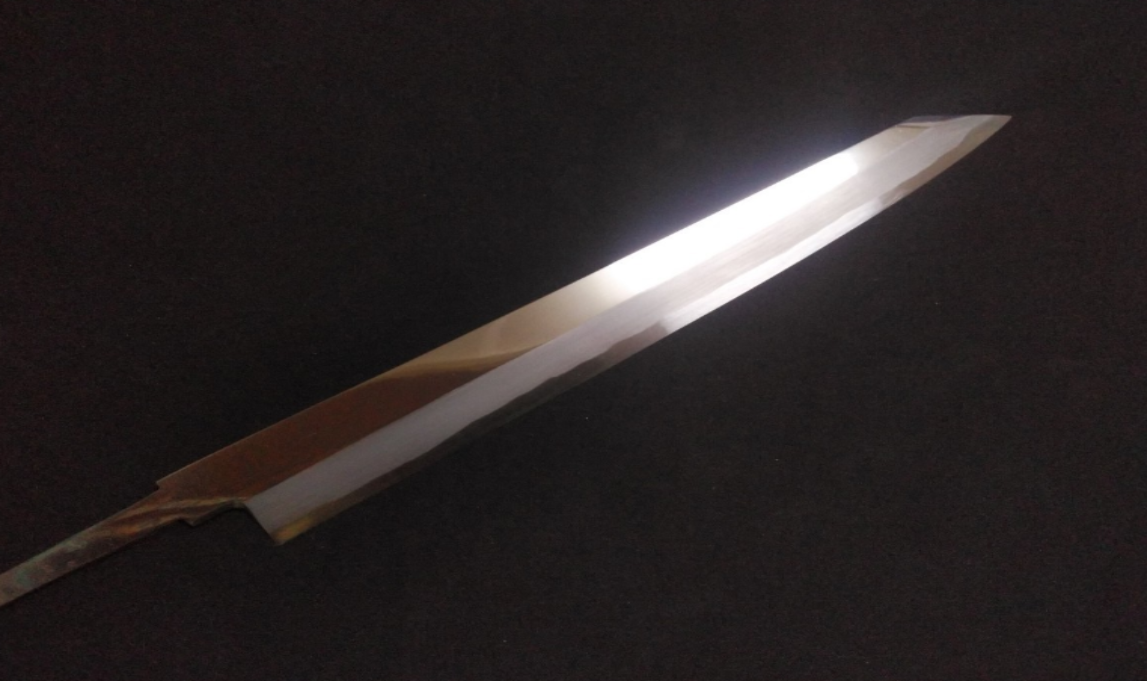
Why Many Product Photos Show Only the Blade
At KIREAJI, every knife is made to order in Sakai, Japan. Photos show the blade before the handle is attached, allowing artisans to perfect the balance and edge for your specific order. Your knife arrives fully finished — tailored just for you.

Global Delivery from Sakai
Across the world, discerning cooks seek authentic Japanese knives from Sakai — Japan’s legendary knife-making city with over 600 years of tradition.
At KIREAJI, we work alongside master artisans in Sakai to fulfill that desire, shipping genuine handcrafted knives directly from the workshop to kitchens worldwide.
Gyuto
-
What Is a Gyuto?
— The Japanese Evolution of the Chef's Knife
-
The Gyuto is the Japanese version of the Western chef’s knife, a versatile tool that has been adapted and refined through the lens of Japanese craftsmanship. Originally introduced from France and Germany during Japan’s modernization in the Meiji era, the chef’s knife found new life in Japanese kitchens.
The name "Gyuto" (literally, 'beef sword') reflects its original purpose—to cut meat. While its shape remains similar to its Western counterpart—with a long, pointed blade designed for slicing meat, fish, and vegetables—it has evolved into something uniquely Japanese.
Today, the Gyuto stands as a symbol of the harmony between utility and precision, offering the performance of a Western chef’s knife with the finesse of Japanese craftsmanship.
-

Features and Uses of the Gyuto
— A Western Foundation Refined by Japanese Technique
While the Gyuto’s roots lie in Western culinary tradition, it has taken on new dimensions thanks to Japan’s dedication to fine craftsmanship.
One key feature is the thin, lightweight blade, which allows for highly controlled, fluid movement—ideal for chefs who value precision over brute force. Unlike heavier Western knives that rely on weight, a Gyuto responds intimately to the movements of your hand.
Common Uses:
- Slicing meat and trimming fat or sinew
- Chopping vegetables with speed and precision
- Filleting fish or preparing sashimi in delicate slices
In short, it is a true all-purpose knife that fits seamlessly into both professional kitchens and home settings.
-
The Appeal of the Gyuto
— A Tool That Grows With Its User
The true charm of a Gyuto lies in how it blends practicality with artistry. Many Gyuto knives are crafted individually by skilled artisans, each one a product of careful steel selection, expert heat treatment, and ergonomic design.
As a result, the Gyuto often feels less like a tool and more like an extension of your hand.
With proper care—sharpening, oiling, and regular maintenance—your Gyuto becomes a lifelong companion, growing more attuned to your needs the longer you use it.In Japanese kitchen culture, a knife is not something to use and toss—it’s a tool to nurture. The Gyuto embodies this philosophy: a knife that sharpens not only your ingredients but your technique and intuition as well.
-

Conclusion
The Gyuto is more than a Japanese chef’s knife—it’s a cultural bridge between Western utility and Japanese sensitivity.
Whether you're slicing beef, chiffonading herbs, or making sashimi, the Gyuto adapts to your hand, your style, and your vision. For anyone seeking a truly versatile, precise, and beautifully made kitchen knife, the Gyuto is a choice that won’t disappoint.
It is, simply put, a knife that elevates your craft.
-
Now that we've explored the features and versatility of the Gyuto, it's time to introduce our carefully curated Gyuto Knife Collection.
Each knife in this collection represents a seamless fusion of Japanese craftsmanship and modern culinary needs.
The Gyuto is truly an all-round performer, ideal for everything from home cooking to professional kitchens.
With its perfect balance of maneuverability and cutting power, the Gyuto is a reliable partner you can count on, no matter the ingredient.You’re sure to find a knife that perfectly complements your cooking style.
Gyuto: The Japanese Answer to the Chef’s Knife
-

The Gyuto blends Western versatility with Japanese finesse, creating a blade that feels both familiar and elevated. Its thin, lightweight profile offers precise control without relying on brute force, while its balanced geometry makes it a truly all-purpose companion for meat, vegetables, and fish alike. More than a tool, the Gyuto becomes an extension of the cook’s hand, refining skill and intuition with every use.
-
Why a Longer Gyuto Blade Can Transform Your Cooking
-
In professional kitchens, longer Gyuto knives are often the blade of choice — and not just for show. A longer blade glides through larger ingredients in a single, smooth stroke, saving time while delivering cleaner, more elegant cuts.
-
More Blade, More Longevity
When slicing, the edge that meets the cutting board naturally dulls over time. With a longer blade, you can shift your cutting point along the edge, keeping your knife sharper for longer and reducing wear on any one section.
-

Control and Flexibility in Every Cut
A longer Gyuto gives you options. You can choose the exact part of the blade that best suits the ingredient — whether it’s the razor-sharp tip for delicate herbs or the midsection for a hearty roast. This flexibility means greater control, precision, and consistency in your cooking.
-
Effortless, Beautiful Slices
The extended length allows for longer, more fluid sliding cuts, enhancing not only efficiency but also presentation. Each slice is cleaner, each motion more natural — the kind of flow professional chefs rely on.
-
Even if you’re buying your first Gyuto, choosing a longer blade can elevate your skills, expand your possibilities, and make every cut feel just a little more like art.
Santoku vs. Gyuto — Which Japanese Knife Should You Choose?
-
When it comes to Japanese kitchen knives, the Santoku and the Gyuto are two of the most beloved and versatile options. While both excel at everyday cooking, their designs and strengths cater to different cutting styles. Understanding these distinctions will help you select the knife that truly complements your cooking style.
-

-
Santoku — The Everyday Performer
- Blade Length: Typically 165–180mm, with some as short as 150mm.
- Shape: Slightly rounded tip with a relatively straight edge, perfect for precise chopping and slicing.
- Strengths: A true all-rounder for meat, fish, and vegetables. Its compact length offers excellent control, especially for push-cutting.
-
Gyuto — The Versatile Powerhouse
- Blade Length: Commonly 180–300mm.
- Shape: A graceful curve from heel to tip, ideal for both push- and pull-cutting.
- Strengths: Longer strokes mean faster, smoother cuts with less fatigue. Excels at precision slicing of meat and fish, even sashimi.
-

How to Decide
Choose the Santoku if you value maneuverability and want a compact, easy-to-control blade for all-purpose use.
Choose the Gyuto if you often work with larger ingredients, need fluid cutting motions, and appreciate the adaptability of both push- and pull-cutting techniques. -
Whichever you choose, both are testaments to Japanese craftsmanship—designed to make every cut cleaner, faster, and more enjoyable.
Santoku vs. Gyuto: Finding the Knife That Fits Your Style
-

The Santoku offers compact control, excelling in everyday chopping with an easy, agile feel. In contrast, the Gyuto delivers length and fluidity, making long, smooth slices effortless across larger ingredients. Understanding this balance—control vs. reach—helps you choose the knife that naturally extends your own cooking rhythm.
-
FAQ About Gyuto

Q1. What is a Gyuto knife used for?
The Gyuto (牛刀) is the Japanese counterpart of the Western chef’s knife, designed for versatility across a wide range of kitchen tasks. It excels in meat preparation such as trimming fat, slicing steaks, and carving roasts, while also performing beautifully with vegetables for chopping, slicing, and julienning. For fish, it is effective in boneless tasks like filleting or removing skin. From herbs to sandwiches, the Gyuto adapts seamlessly to both Japanese and Western cooking styles, making it a favorite of home cooks and professional chefs alike.
Q2. What are the key advantages of a Gyuto?
The Gyuto is prized for its precision and efficiency. Its thin blade cuts with minimal resistance, while the fine edge delivers clean slices without crushing food. The pointed tip allows detailed work like trimming or scoring, and the long blade is ideal for smooth drawing cuts, such as slicing roast beef or sashimi blocks. Together, these features provide excellent control and performance in both everyday and professional settings.
Q3. Why do chefs prefer Gyuto knives?
Chefs appreciate the Gyuto for its balance of power, precision, and adaptability. The narrow blade reduces drag, improving slicing efficiency, while the length allows for long, clean strokes. It supports both push-cutting and pull-cutting techniques, making it highly versatile across cuisines. Its refined appearance also makes it a favorite in open kitchens and chef’s counters where presentation matters as much as performance.
Q4. Why is it called a “Gyuto”?
“Gyuto” literally translates to “beef sword” in Japanese. The name reflects its Western origins: the Gyuto was inspired by European chef’s knives, which were initially designed for cutting large cuts of beef. As Western cuisine spread in Japan, the term “Gyuto” was adopted to describe this style of knife.
Q5. Are there any disadvantages to using a Gyuto?
While the Gyuto is versatile, it has some limitations. Its sharp pointed tip can be more hazardous than a Santoku if handled carelessly. It is not intended for cutting through bones or frozen foods, and its longer blade may feel unwieldy in small kitchens or for beginners. Some heavier models can also cause fatigue during extended use. With proper care and technique, however, these drawbacks are easily managed.
Q6. What is the difference between a Gyuto and a Santoku?
Both are multipurpose knives, but they differ in design and character. The Gyuto has a longer, narrower blade with a pointed tip, making it ideal for precise slicing, trimming, and handling larger ingredients. The Santoku, on the other hand, is shorter, with a wider blade and a rounded tip, optimized for home kitchens and general tasks. In short, the Gyuto offers greater reach and precision, while the Santoku provides ease of use and versatility for everyday cooking.
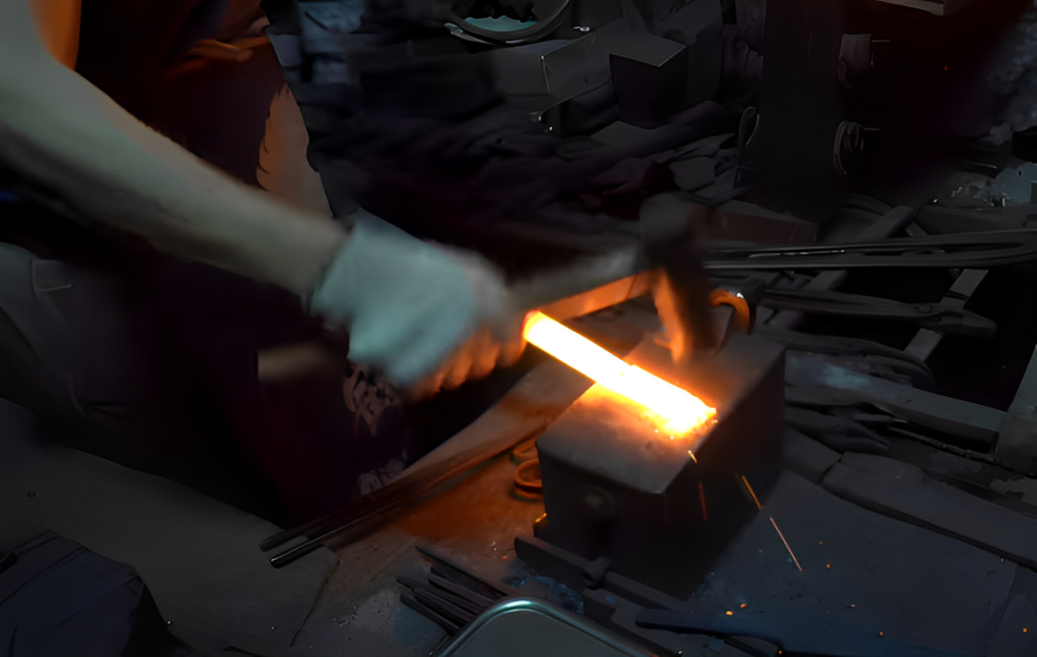
The Soul of Craftsmanship
-
The Timeless Charm of the Gyuto — Precision Meets Versatility
The Gyuto knife is more than just a versatile kitchen tool—it is a symbol of balance and mastery. With its elegant curve and razor-sharp edge, the Gyuto glides effortlessly through meat, fish, and vegetables, embodying the seamless fusion of beauty and performance.
-
Its signature feature is the gentle curve from base to tip, designed to minimize contact with the cutting board. This allows for a smooth rocking motion, enabling chefs to slice with speed, accuracy, and grace while preserving the integrity of each ingredient.
-
But the true value of the Gyuto lies beyond versatility. For passionate cooks, it becomes a partner that evolves with them—a knife that not only enhances precision, but also deepens one’s relationship with cooking itself.
-
Every Gyuto we craft is born from centuries of Japanese blade-making tradition, refined for today’s kitchens. To hold one is to experience both reliability and inspiration—a trusted companion that elevates everyday preparation into the art of cuisine.
How Japanese Knives Are Made: The Sakai Tradition
VIDEO PROVIDED: JAPAN TRADITIONAL CRAFTS AOYAMA SQUARE (YOUTUBE)
-
Sakai Forged Blades — Six Centuries of Unrivaled Craftsmanship
Loved by chefs around the world and trusted by 98% of Japan’s top culinary professionals, Sakai knives are more than tools—they are the living legacy of over 600 years of master craftsmanship.
-
At KIREAJI, we work directly with the Shiroyama Knife Workshop in Sakai, Japan, ensuring every blade is hand-forged, finished to perfection, and shipped straight from the workshop to kitchens across the globe. No middlemen. No mass production. Only authentic, artisan-made knives, crafted to elevate your cooking for a lifetime.




